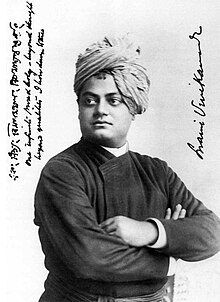The word Hindu is derived from the Indo-Aryan
/Sanskrit
word Sindhu, the Indo-Aryan name for the Indus River
in the northwestern part of the Indian subcontinent
(modern day Pakistan and Northern India
). According to Gavin Flood
, "The actual term 'hindu' first occurs as a Persian
geographical term for the people who lived beyond the river Indus (Sanskrit: Sindhu)", more specifically in the 6th-century BCE inscription of Darius I.The term 'Hindu' in these ancient records is a geographical term and did not refer to a religion. Among the earliest known records of 'Hindu' with connotations of religion may be in the 7th-century CE Chinese text Record of the Western Regions by Xuanzang
,and 14th-century Persian text Futuhu's-salatin by 'Abd al-Malik Isami.
Thapar states that the word Hindu is found as heptahindu in Avesta – equivalent to Rigvedic sapta sindhu, while hndstn (pronounced Hindustan) is found in a Sasanian inscription from the 3rd century CE, both of which refer to parts of northwestern South Asia. The Arabic term al-Hind referred to the people who live across the River Indus.This Arabic term was itself taken from the pre-Islamic Persian term Hindū, which refers to all Indians. By the 13th century, Hindustan emerged as a popular alternative name of India, meaning the "land of Hindus".
The term Hindu was later used occasionally in some Sanskrit texts such as the later Rajataranginis of Kashmir (Hinduka, c. 1450) and some 16th- to 18th-century Bengali Gaudiya Vaishnava texts including Chaitanya Charitamrita and Chaitanya Bhagavata. These texts used it to contrast Hindus from Muslims who are calledYavanas (foreigners) or Mlecchas (barbarians), with the 16th-century Chaitanya Charitamrita text and the 17th century Bhakta Mala text using the phrase "Hindudharma". It was only towards the end of the 18th century that European merchants and colonists began to refer to the followers of Indian religions collectively as Hindus. The term Hinduism was introduced into the English language in the 19th century to denote the religious, philosophical, and cultural traditions native to India.
Definitions
The study of India and its cultures and religions, and the definition of "Hinduism", has been shaped by the interests of colonialism and by Western notions of religion. Since the 1990s, those influences and its outcomes have been the topic of debate among scholars of Hinduism, and have also been taken over by critics of the Western view on India.
Hinduism includes a diversity of ideas on spirituality and traditions, but has no ecclesiastical order, no unquestionable religious authorities, no governing body, no prophet(s) nor any binding holy book; Hindus can choose to be polytheistic, pantheistic, monotheistic, monistic, agnostic, atheistic or humanist. Because of the wide range of traditions and ideas covered by the term Hinduism, arriving at a comprehensive definition is difficult. The religion "defies our desire to define and categorize it". Hinduism has been variously defined as a religion, a religious tradition, a set of religious beliefs, and "a way of life."From a Western lexical standpoint, Hinduism like other faiths is appropriately referred to as a religion. In India the term dharma is preferred, which is broader than the western term "religion". Hindu traditionalists prefer to call it Sanatana Dharma (the eternal or ancient dharma).
Colonial influences
The notion of common denominators for several religions and traditions of India was already noted from the 12th century CE on.The notion and reports on "Hinduism" as a "single world religious tradition" was popularised by 19th-century proselytizing missionaries and European Indologists, roles sometimes served by the same person, who relied on texts preserved by Brahmins (priests) for their information of Indian religions, and animist observations which the missionary Orientalists presumed was Hinduism. These reports influenced perceptions about Hinduism. Some scholars state that the colonial polemical reports led to fabricated stereotypes where Hinduism was mere mystic paganism devoted to the service of devils, while other scholars state that the colonial constructions influenced the belief that the
Vedas,
Bhagavad Gita,
Manusmriti and such texts were the essence of Hindu religiosity, and in the modern association of 'Hindu doctrine' with the schools of Vedanta (in particular Advaita Vedanta) as paradigmatic example of Hinduism's mystical nature".Pennington, while concurring that the study of Hinduism as a world religion began in the colonial era, disagrees that Hinduism is a colonial European era invention.
[53] He states that the shared theology, common ritual grammar and way of life of those who identify themselves as Hindus is traceable to ancient times.
Indigenous understanding
Sanātana Dharma
To its adherents, Hinduism is a traditional way of life. Many practitioners refer to Hinduism as Sanātana Dharma, "the eternal law" or the "eternal way". It refers to the "eternal" duties all Hindus have to follow, regardless of class, caste, or sect, such as honesty, refraining from injuring living beings, purity, goodwill, mercy, patience, forbearance, self-restraint, generosity, and asceticism. This is contrasted with svadharma, one's "own duty", the duties to be followed by members of a specific caste and stage of life. According to Knott, this also
... refers to the idea that its origins lie beyond human history, and its truths have been divinely revealed (shruti) and passed down through the ages to the present day in the most ancient of the world's scriptures, the Veda. (Knott 1998, p. 5)
According to the Encyclopædia Britannica;-
The term has also more recently been used by Hindu leaders, reformers, and nationalists to refer to Hinduism as a unified world religion. Sanatana dharma has thus become a synonym for the "eternal" truth and teachings of Hinduism, the latter conceived of as not only transcendent of history and unchanging but also as indivisible and ultimately nonsectarian.
The Sanskrit word dharma has a much deeper meaning than religion and is not its equivalent. All aspects of a Hindu life, namely acquiring wealth (Artha), fulfillment of desires (kama), and attaining liberation (moksha) are part of dharma which encapsulates the "right way of living" and eternal harmonious principles in their fulfillment.
Growing Hindu identity
This sense of unity and ancientness has been developed over a longer period. According to Nicholson, already between the 12th and the 16th centuries "certain thinkers began to treat as a single whole the diverse philosophical teachings of the Upanishads, epics, Puranas, and the schools known retrospectively as the "six systems" (saddarsana) of mainstream Hindu philosophy. The tendency of "a blurring of philosophical distinctions" has also been noted by Burley. Hacker called this "inclusivism" and Michaels speaks of "the identificatory habit". Lorenzen locates the origins of a distinct Hindu identity in the interaction between Muslims and Hindus, and a process of "mutual self-definition with a contrasting Muslim other", which started well before 1800. Michaels notes:
As a counteraction to Islamic supremacy and as part of the continuing process of regionalization, two religious innovations developed in the Hindu religions: the formation of sects and a historicization which preceded later nationalism [...] [S]aints and sometimes militant sect leaders, such as the Marathi poet Tukaram (1609-1649) and Ramdas (1608-1681), articulated ideas in which they glorified Hinduism and the past. The Brahmins also produced increasingly historical texts, especially eulogies and chronicles of sacred sites (Mahatmyas), or developed a reflexive passion for collecting and compiling extensive collections of quotations on various subjects.
This inclusivism was further developed in the 19th and 20th centuries by Hindu reform movements and Neo-Vedanta,and has become characteristic of modern Hinduism.
Hindu modernism

Swami Vivekananda was a key figure in introducing Vedanta and Yoga in Europe and USA, raising interfaith awareness and making Hinduism a world religion.
Beginning in the 19th century, Indian modernists re-asserted Hinduism as a major asset of Indian civilisation, meanwhile "purifying" Hinduism from its Tantric elements and elevating the Vedic elements. Western stereotypes were reversed, emphasizing the universal aspects, and introducing modern approaches of social problems. This approach had a great appeal, not only in India, but also in the west.Major representatives of "Hindu modernism"are Raja Rammohan Roy,Vivekananda, Sarvepalli Radhakrishnan and Mahatma Gandhi.
Raja Rammohan Roy is known as the father of the Hindu Renaissance. He was a major influence on Swami Vivekananda (1863-1902), who, according to Flood, was "a figure of great importance in the development of a modern Hindu self-understanding and in formulating the West's view of Hinduism." Central to his philosophy is the idea that the divine exists in all beings, that all human beings can achieve union with this "innate divinity", and that seeing this divine as the essence of others will further love and social harmony. According to Vivekananda, there is an essential unity to Hinduism, which underlies the diversity of its many forms. According to Flood, Vivekananda's vision of Hinduism "is one generally accepted by most English-speaking middle-class Hindus today."
Sarvepalli Radhakrishnan was "one of India's most erudite scholars to engage with western and Indian philosophy". He sought to reconcile western rationalism with Hinduism, "presenting Hinduism as an essentially rationalistic and humanistic religious experience." This "Global Hinduism" has a worldwide appeal, transcending national boundaries and, according to Flood, "becoming a world religion alongside Christianity, Islam and Buddhism", both for the Hindu diaspora communities and for westerners who are attracted to non-western cultures and religions. It emphasizes universal spiritual values such as social justice, peace and "the spiritual transformation of humanity." It has developed partly due to "re-enculturation", or the Pizza effect, in which elements of Hindu culture have been exported to the West, gaining popularity there, and as a consequence also gained greater popularity in India. This globalization of Hindu culture was initiated by Swami Vivekananda and his founding of the Ramakrishna Mission, an effort continued by other teachers, "bringing to the West teachings which have become an important cultural force in western societies, and which in turn have become an important cultural force in India, their place of origin."
Western understanding
Western scholars regard Hinduism as a fusion or synthesis of various Indian cultures and traditions.
Hinduism's tolerance to variations in belief and its broad range of traditions make it difficult to define as a religion according to traditional Western conceptions.
Some academics suggest that Hinduism can be seen as a category with "fuzzy edges" rather than as a well-defined and rigid entity. Some forms of religious expression are central to Hinduism and others, while not as central, still remain within the category. Based on this idea Ferro-Luzzi has developed a 'Prototype Theory approach' to the definition of Hinduism.







